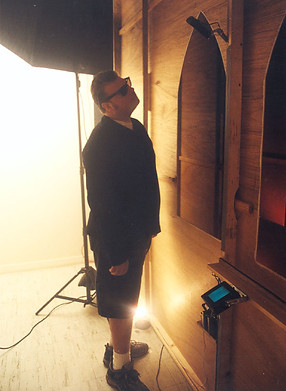Redundant Gothic
Corridors
Harbor College Art Gallery, 2000
"Four centuries after the 'solutions' of the Renaissance and three centuries after Descartes, depth is still new, and it insists on being sought, not 'once in a lifetime' but all through life."
-Maurice Merleau-Ponty
A set constructed in the gallery at Harbor College.
2-D representations of 3-D space, from renaissance paintings to contemporary news and advertising photos, are based on a fixed point of view. This set piece uses the device of forced perspective (familiar to many from first year psychology texts or Fun Houses) to externalize the point of view. Once the point of view is out in the room, it can be taken or assumed by a viewer who will see the constructed illusion of 3 dimensions just as it would appear in 2 dimensions. As the viewer moves away from the fixed pov however, their perception of the illusion begins to distort until, at some point, it completely breaks down giving way to a recognition of the materials from which the piece is made and its configuration within the actual 3-d space of the room.
At the back of the set two small monitors play unedited footage of people reading. Viewers of the video assume contemplative poses much like those of the readers they watch and present a similar image through the set to anyone who chances into the gallery.
The movement of viewers in the gallery activates a linear sequence that repeats each time a new viewer enters the space.



Summary
Redundant Gothic Corridors is a SET that can be constructed in an interior space, a hallway, or alley. It is composed of six stage flats lined up one after the other. Mathematical calculations for the creation of a one-point perspective are used to position the flats and measure the size of openings to be cut in each to create a forced perspective. It is designed to be approached from a single angle but afterward may be inspected from three sides.
Perspective and Point Of View
As film/video makers we have accepted many of the conventions and limitations inherited from painting and photography. With few exceptions the images we create are flat, they are created on a flat plane (chip of film or silicon) and regardless of whether we project them back out onto a plane, sphere or other shape, they are light on a surface, they have no physical depth. Any illusion of depth they may possess derives in one way or another from the phenomenon of perspective. One of the most interesting features of visual perspective is that it locks the viewer’s point of view to that of the painter or photographer no matter how a viewer repositions themselves relative to a picture they continue to see it from the single point of view from which it was made. "Corridors" allows the viewer to perform a sort of Alice In Wonderland trick and step into the picture and then walk around the illusion! This is even more fun than it sounds. Locked to the point of view of the creator of the perspective in a flat picture the scene must always appear ‘natural’ but externalize that same perspective into three-dimensional space and you have an odd thing indeed. A viewer directed to approach the sculpture from ‘the’ point of view that it replicates sees nothing extraordinary at first but as they move away from that point of view reality begins to warp. The disorienting, hallucinatory effect lasts only an instant but the intellectual delight that accompanies the rest of the inspection is more enduring. To be able to see perspective as a ‘thing’ sets off a cascade of considerations about how we construct the visual that goes to the heart of our enterprise as artists.
This piece 'plays' like a very short linear sequence as the trick reveals itself. It has a beginning a middle and an end and so is as linked to time-based work as it is to sculpture or painting.




